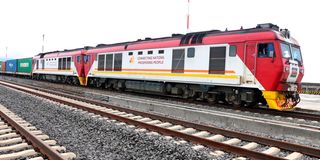Premium
China to charge toll on last phase of Naivasha-Kisumu SGR

An SGR train at the Naivasha Inland Container Depot on January 17, 2022.
A consortium of Chinese firms will charge the toll on the last 40 percent of the third leg of the standard gauge railway (SGR) from Naivasha to Malaba, the National Treasury has said.
National Treasury Cabinet Secretary John Mbadi said the government is in discussion with Chinese firms to extend the line from Naivasha to Uganda.
Mr Mbadi did not disclose the amount of time that the consortium of Chinese firms will take to recoup their investments.
“The last 40 percent of the SGR line will be built by a consortium of Chinese companies,” Mr Mbadi told the Budget and Appropriations Committee (BAC) on Thursday.
“They will charge for the use of the railway line.”
Mr Mbadi told the committee chaired by Alego Usonga MP Samuel Atandi that funding for the Naivasha-Malaba stretch is being negotiated with Beijing firms.
He said over 50 percent of the Mombasa-Naivasha SGR loan would be repaid up to the year 2029. “We are negotiating with Chinese companies to fund the last leg of the SGR,” Mr Mbadi said during the public participation of the Division of Revenue Bill, 2025.
“It is possible to negotiate with China for a loan with a grace period after 2029.”
The minister said 30 percent of the new SGR loans would be sourced externally while another 30 percent or Sh45 billion annually would be provided for by the government.
“The remaining 40 percent of the SGR loan will be sourced from a consortium of Chinese firms who will recoup their money through toll for the use of the railway,” Mr Mbadi said.
The government, he said, is already undertaking an inventory of settlements and assets to be displaced by the construction of the final leg of the SGR that will be linked to Uganda.
The Kenya Railways Corporation last year recruited a consultant to undertake the mapping and propose a compensation and resettlement plan for all affected by the works on the 255-kilometre proposed project route that traverses Narok, Bomet, Kericho and Kisumu.
Treasury last year revealed that the commercial terms for the construction of the third leg of the SGR from Naivasha to Malaba had been agreed, setting the stage for the completion of Phase 2 B of the modern railway.
Phase 2 B is to run from Naivasha to Malaba while Phase 2 A runs from Nairobi to Naivasha.
Phase 1 runs from Mombasa to Nairobi. A plan from the Kenya Railways Corporation shows that Phase 2 B of the SGR project will include the construction of the 255-kilometre line from Narok to Kisumu with modifications of the Kisumu port, including an eight-kilometre branch line.
The key components of the proposed project include rail, sleepers, tunnels, bridges, stations and locomotives.
The proposed port will entail the construction of two multipurpose berths and a workboat berth so as to safely accommodate safe laying of ships.
Both Kenya and Uganda have expressed interest in extending the SGR project, to link the two nations and provide connections to South Sudan, Rwanda and the DR Congo.
Phase 3 of the project involves the construction of the Naivasha to Kampala. Uganda to Kigali, Rwanda line for which feasibility and preliminary designs are also being undertaken, the Kenyan government said.
The extension of the modern railway from Naivasha’s Mai Mahiu to the border of Uganda will see the multi-billion-dollar railway line run through Narok, Bomet, Nyamira, Kisumu, and finally Malaba.
Also Read: Ruto, China and dark SGR secrets
Kenya spent $3.6 billion to construct the SGR. One of the most expensive infrastructure projects as at the time it was launched in 2013.
The prime contractor was the China Road & Bridge Corporation CRBC, which hired 25,000 Kenyans to work on the railway.

